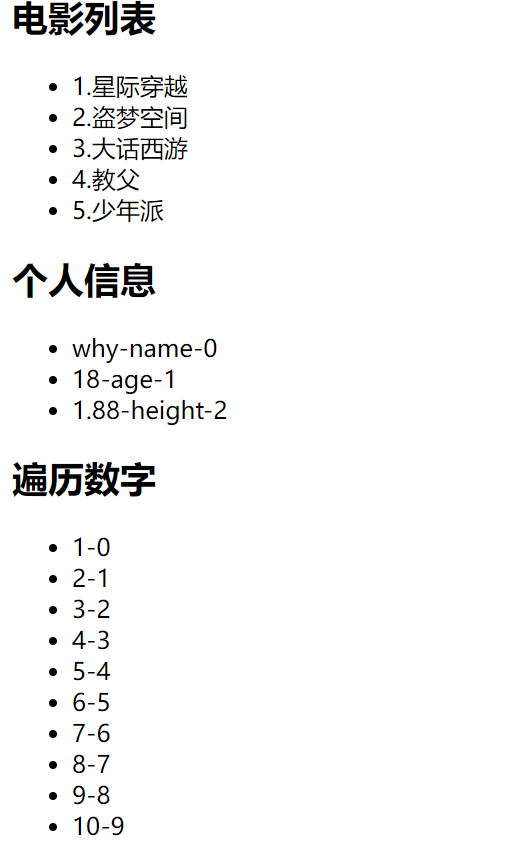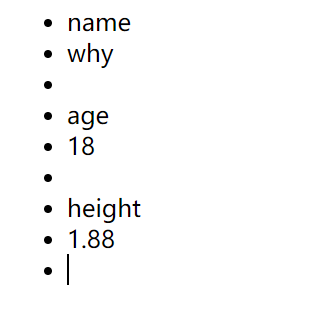7. 列表渲染
- 在真实开发中,我们往往会从服务器拿到一组数据,并且需要对其进行渲染。
- 这个时候我们可以使用v-for来完成;
- v-for类似于JavaScript的for循环,可以用于遍历一组数据;
7.1 v-for的基本使用
v-for的基本格式是 "item in 数组":- 数组通常是来自data或者prop,也可以是其他方式;
- item是我们给每项元素起的一个别名,这个别名可以自定来定义;
- 我们知道,在遍历一个数组的时候会经常需要拿到数组的索引:
- 如果我们需要索引,可以使用格式: "(item, index) in 数组";
- 注意上面的顺序:数组元素项item是在前面的,索引项index是在后面的;
示例:

v-for也支持遍历对象,并且支持有一二三个参数:- 一个参数: "value in object";
- 二个参数: "(value, key) in object"; key表示为属性名
- 三个参数: "(value, key, index) in object"; index为索引
v-for同时也支持数字的遍历:- 每一个item都是一个数字;
vue
<div id="app"></div>
<template id="my-app">
<h2>电影列表</h2>
<ul>
<!-- 遍历数组 -->
<li v-for="(movie, index) in movies">{{index+1}}.{{movie}}</li>
</ul>
<h2>个人信息</h2>
<ul>
<!-- 遍历对象 -->
<li v-for="(value, key, index) in info">{{value}}-{{key}}-{{index}}</li>
</ul>
<h2>遍历数字</h2>
<ul>
<li v-for="(num, index) in 10">{{num}}-{{index}}</li>
</ul>
</template>
<script src="../js/vue.js"></script>
<script>
const App = {
template: '#my-app',
data() {
return {
movies: [
"星际穿越",
"盗梦空间",
"大话西游",
"教父",
"少年派"
],
info: {
name: "why",
age: 18,
height: 1.88
}
}
}
}
Vue.createApp(App).mount('#app');
</script>7.2 v-for和template
- 类似于
v-if,可以使用template元素来循环渲染一段包含多个元素的内容: - 我们使用
template来对多个元素进行包裹,而不是使用div来完成
示例:

vue
<div id="app"></div>
<template id="my-app">
<ul>
<template v-for="(value, key) in info">
<li>{{key}}</li>
<li>{{value}}</li>
<li class="divider"></li>
</template>
</ul>
</template>
<script src="../js/vue.js"></script>
<script>
const App = {
template: '#my-app',
data() {
return {
info: {
name: "why",
age: 18,
height: 1.88
}
}
}
}
Vue.createApp(App).mount('#app');
</script>7.3v-for 与 v-if
注意
同时使用 v-if 和 v-for 是****不推荐的****,因为这样二者的优先级不明显。
当它们同时存在于一个节点上时,v-if 比 v-for 的优先级更高。这意味着 v-if 的条件将无法访问到 v-for 作用域内定义的变量别名:
vue
<!--
这会抛出一个错误,因为属性 todo 此时
没有在该实例上定义
-->
<li v-for="todo in todos" v-if="!todo.isComplete">
{{ todo.name }}
</li>在外新包装一层 <template> 再在其上使用 v-for 可以解决这个问题 (这也更加明显易读):
vue
<template v-for="todo in todos">
<li v-if="!todo.isComplete">
{{ todo.name }}
</li>
</template>7.4 v-for中key的作用
- key属性主要用在Vue的虚拟DOM算法,在新旧nodes对比时辨识VNodes;
- 如果不使用key,Vue会使用一种最大限度减少动态元素并且尽可能的尝试就地修改/复用相同类型元素的算法;
- 而使用key时,它会基于key的变化重新排列元素顺序,并且会移除/销毁key不存在的元素;
VNode的概念:
- VNode的全称是Virtual Node,也就是虚拟节点;
- 事实上,无论是组件还是元素,它们最终在Vue中表示出来的都是一个个VNode;
- VNode的本质是一个JavaScript的对象;
Vue事实上会对于有key和没有key会调用两个不同的方法;
- 有key,那么就使用 patchKeyedChildren方法;
- 没有key,那么就使用 patchUnkeyedChildren方法;
vue源码对没有key的操作:
ts
const patchUnkeyedChildren = (
c1: VNode[],
c2: VNodeArrayChildren,
container: RendererElement,
anchor: RendererNode | null,
parentComponent: ComponentInternalInstance | null,
parentSuspense: SuspenseBoundary | null,
isSVG: boolean,
slotScopeIds: string[] | null,
optimized: boolean
) => {
c1 = c1 || EMPTY_ARR
c2 = c2 || EMPTY_ARR
//1.获取旧节点的长度
const oldLength = c1.length
//2.获取新节点的长度
const newLength = c2.length
//获取最小的那个长度
const commonLength = Math.min(oldLength, newLength)
let i
// 3.从0位置开始依次patch比较
for (i = 0; i < commonLength; i++) {
const nextChild = (c2[i] = optimized
? cloneIfMounted(c2[i] as VNode)
: normalizeVNode(c2[i]))
patch(
c1[i],
nextChild,
container,
null,
parentComponent,
parentSuspense,
isSVG,
slotScopeIds,
optimized
)
}
// 4.如果旧的节点数大于新的节点数
if (oldLength > newLength) {
// remove old
// 移除剩余的节点
unmountChildren(
c1,
parentComponent,
parentSuspense,
true,
false,
commonLength
)
} else {
// mount new
// 创建新的节点
mountChildren(
c2,
container,
anchor,
parentComponent,
parentSuspense,
isSVG,
slotScopeIds,
optimized,
commonLength
)
}
}c和d来说它们事实上并不需要有任何的改动;
但是因为我们的c被f所使用了,所有后续所有的内容都要一次进行改动,并且最后进行新增;

vue源码对有key执行的操作:
ts
const patchKeyedChildren = (
c1: VNode[],
c2: VNodeArrayChildren,
container: RendererElement,
parentAnchor: RendererNode | null,
parentComponent: ComponentInternalInstance | null,
parentSuspense: SuspenseBoundary | null,
isSVG: boolean,
slotScopeIds: string[] | null,
optimized: boolean
) => {
let i = 0
const l2 = c2.length
let e1 = c1.length - 1 // prev ending index
let e2 = l2 - 1 // next ending index
// 1. sync from start
// 1. 从头部开始遍历,遇到相同的节点就继续,遇到不同的就跳出循环
// (a b) c
// (a b) d e
while (i <= e1 && i <= e2) {
const n1 = c1[i]
const n2 = (c2[i] = optimized
? cloneIfMounted(c2[i] as VNode)
: normalizeVNode(c2[i]))
if (isSameVNodeType(n1, n2)) {
patch(
n1,
n2,
container,
null,
parentComponent,
parentSuspense,
isSVG,
slotScopeIds,
optimized
)
} else {
break
}
i++
}
// 2. sync from end
// 2.从尾部开始遍历,遇到相同的节点就继续,遇到不同的就跳出循环
// a (b c)
// d e (b c)
while (i <= e1 && i <= e2) {
const n1 = c1[e1]
const n2 = (c2[e2] = optimized
? cloneIfMounted(c2[e2] as VNode)
: normalizeVNode(c2[e2]))
if (isSameVNodeType(n1, n2)) {
patch(
n1,
n2,
container,
null,
parentComponent,
parentSuspense,
isSVG,
slotScopeIds,
optimized
)
} else {
break
}
e1--
e2--
}
// 3. common sequence + mount
// 3.如果最后新节点更多,那么就添加新节点
// (a b)
// (a b) c
// i = 2, e1 = 1, e2 = 2
// (a b)
// c (a b)
// i = 0, e1 = -1, e2 = 0
if (i > e1) {
if (i <= e2) {
const nextPos = e2 + 1
const anchor = nextPos < l2 ? (c2[nextPos] as VNode).el : parentAnchor
while (i <= e2) {
patch(
null,
(c2[i] = optimized
? cloneIfMounted(c2[i] as VNode)
: normalizeVNode(c2[i])),
container,
anchor,
parentComponent,
parentSuspense,
isSVG,
slotScopeIds,
optimized
)
i++
}
}
}
// 4. common sequence + unmount
// 4.如果旧节点更多,那么就移除旧节点
// (a b) c
// (a b)
// i = 2, e1 = 2, e2 = 1
// a (b c)
// (b c)
// i = 0, e1 = 0, e2 = -1
else if (i > e2) {
while (i <= e1) {
unmount(c1[i], parentComponent, parentSuspense, true)
i++
}
}
// 5. unknown sequence
// 5. 如果中间存在不知道如何排列的位置序列,那么就使用key建立索引图最大限度的使用旧节点
// [i ... e1 + 1]: a b [c d e] f g
// [i ... e2 + 1]: a b [e d c h] f g
// i = 2, e1 = 4, e2 = 5
else {
const s1 = i // prev starting index
const s2 = i // next starting index
// 5.1 build key:index map for newChildren
const keyToNewIndexMap: Map<string | number | symbol, number> = new Map()
for (i = s2; i <= e2; i++) {
const nextChild = (c2[i] = optimized
? cloneIfMounted(c2[i] as VNode)
: normalizeVNode(c2[i]))
if (nextChild.key != null) {
if (__DEV__ && keyToNewIndexMap.has(nextChild.key)) {
warn(
`Duplicate keys found during update:`,
JSON.stringify(nextChild.key),
`Make sure keys are unique.`
)
}
keyToNewIndexMap.set(nextChild.key, i)
}
}
// 5.2 loop through old children left to be patched and try to patch
// matching nodes & remove nodes that are no longer present
let j
let patched = 0
const toBePatched = e2 - s2 + 1
let moved = false
// used to track whether any node has moved
let maxNewIndexSoFar = 0
// works as Map<newIndex, oldIndex>
// Note that oldIndex is offset by +1
// and oldIndex = 0 is a special value indicating the new node has
// no corresponding old node.
// used for determining longest stable subsequence
const newIndexToOldIndexMap = new Array(toBePatched)
for (i = 0; i < toBePatched; i++) newIndexToOldIndexMap[i] = 0
for (i = s1; i <= e1; i++) {
const prevChild = c1[i]
if (patched >= toBePatched) {
// all new children have been patched so this can only be a removal
unmount(prevChild, parentComponent, parentSuspense, true)
continue
}
let newIndex
if (prevChild.key != null) {
newIndex = keyToNewIndexMap.get(prevChild.key)
} else {
// key-less node, try to locate a key-less node of the same type
for (j = s2; j <= e2; j++) {
if (
newIndexToOldIndexMap[j - s2] === 0 &&
isSameVNodeType(prevChild, c2[j] as VNode)
) {
newIndex = j
break
}
}
}
if (newIndex === undefined) {
unmount(prevChild, parentComponent, parentSuspense, true)
} else {
newIndexToOldIndexMap[newIndex - s2] = i + 1
if (newIndex >= maxNewIndexSoFar) {
maxNewIndexSoFar = newIndex
} else {
moved = true
}
patch(
prevChild,
c2[newIndex] as VNode,
container,
null,
parentComponent,
parentSuspense,
isSVG,
slotScopeIds,
optimized
)
patched++
}
}
// 5.3 move and mount
// generate longest stable subsequence only when nodes have moved
const increasingNewIndexSequence = moved
? getSequence(newIndexToOldIndexMap)
: EMPTY_ARR
j = increasingNewIndexSequence.length - 1
// looping backwards so that we can use last patched node as anchor
for (i = toBePatched - 1; i >= 0; i--) {
const nextIndex = s2 + i
const nextChild = c2[nextIndex] as VNode
const anchor =
nextIndex + 1 < l2 ? (c2[nextIndex + 1] as VNode).el : parentAnchor
if (newIndexToOldIndexMap[i] === 0) {
// mount new
patch(
null,
nextChild,
container,
anchor,
parentComponent,
parentSuspense,
isSVG,
slotScopeIds,
optimized
)
} else if (moved) {
// move if:
// There is no stable subsequence (e.g. a reverse)
// OR current node is not among the stable sequence
if (j < 0 || i !== increasingNewIndexSequence[j]) {
move(nextChild, container, anchor, MoveType.REORDER)
} else {
j--
}
}
}
}
}- 第一步的操作是从头开始进行遍历、比较:

a和b是一致的会继续进行比较;
c和f因为key不一致,所以就会break跳出循环;
第二步的操作是从尾部开始进行遍历、比较:

第三步是如果旧节点遍历完毕,但是依然有新的节点,那么就新增节点:

第四步是如果新的节点遍历完毕,但是依然有旧的节点,那么就移除旧节点: 有key的diff算法如下(二) coderwhy

第五步是最特色的情况,中间还有很多未知的或者乱序的节点:

所以我们可以发现,Vue在进行diff算法的时候,会尽量利用我们的key来进行优化操作:
- 在没有key的时候我们的效率是非常低效的;
- 在进行插入或者重置顺序的时候,保持相同的key可以让diff算法更加的高效;
7.5 数组的修改方法
Vue 将被侦听的数组的变更方法进行了包裹,所以它们也将会触发视图更新。这些被包裹过的方法包括
push()
pop()
shift()
unshift()
splice()
sort()
reverse()
替换数组的方法
- 上面的方法会直接修改原来的数组,但是某些方法不会替换原来的数组,而是会生成新的数组,比如 filter()、 concat() 和 slice()
示例:
vue
<div id="app"></div>
<template id="my-app">
<h2>电影列表</h2>
<ul>
<li v-for="(movie, index) in movies">{{index+1}}.{{movie}}</li>
</ul>
<input type="text" v-model="newMovie">
<button @click="addMovie">添加电影</button>
</template>
<script src="../js/vue.js"></script>
<script>
const App = {
template: '#my-app',
data() {
return {
newMovie: "",
movies: [
"星际穿越",
"盗梦空间",
"大话西游",
"教父",
"少年派"
]
}
},
methods: {
addMovie() {
this.movies.push(this.newMovie);
this.newMovie = "";
// this.movies = this.movies.filter(item => item.length > 2);
}
}
}
Vue.createApp(App).mount('#app');
</script>